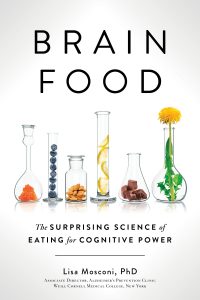Reprinted from Brain Food: The Surprising Science of Eating for Cognitive Power by arrangement with Avery, an imprint of Penguin Publishing Group, a division of Penguin Random House LLC. Copyright © 2018, Lisa Mosconi.
BY LISA MOSCONI, PH.D.
The rumba and the cha-cha . . . horseback riding and even snorkeling. While these might not be the first things that  come to mind when contemplating how to keep your brain in top shape, they might very well be the ideal prescription.
come to mind when contemplating how to keep your brain in top shape, they might very well be the ideal prescription.
Exercise has been touted to be a cure for nearly everything, from menstrual cramps and osteoporosis to obesity, type 2 diabetes, heart disease, and depression. It is also the latest addition to the growing list of lifestyle factors that help protect our brain against disease.
However, the evidence that exercise provides substantial benefits for the brain has yet to be fully accepted by the mainstream medical community. For example, if you were to see a neurologist with concerns about memory loss, it’s unlikely you’d walk out with a prescription for physical therapy or exercise. Even the most enlightened of doctors would be hard-pressed to recommend a specific fitness regime as an answer to your prayers. Should I run every day? Lift weights? Take a Pilates class? The truth is, there are still no uniformly established medical recommendations for “brain fitness.”
But we are getting there. An emerging body of scientific literature is documenting the beneficial influence of physical activity on the brain as well as on the body. The physically fit elderly typically perform better on reasoning and working memory tasks, and their reaction time is also quicker than that of sedentary elderly.
There are many good reasons for your brain to enjoy exercise. First, exercise promotes heart health—and we discussed before, what’s good for the heart is good for the brain. Physical activity, especially aerobic (the kind of exercise that makes your heart beat faster), enhances blood flow and circulation, improves the delivery of oxygen and nutrients to your brain, and also slows down the buildup of plaque in your arteries. This is particularly useful as we age, since our blood flow to the brain would otherwise naturally slow down.
Exercise is also a natural antidepressant. Don’t you feel more relaxed and in a much better mood after a workout? Your brain does, too. That’s because, whether you are into yoga or running, exercise pumps up your endorphins, our body’s natural painkillers, while increasing production of your serotonin, making you feel happier. The famous “joggers’ high” is nothing less than exercise impacting the opioid system in the brain—the same system that is activated by drugs like opium, a muscle relaxant. Exercise however allows us a natural high as it delivers pain relief, relaxation, and even euphoria, producing an overall sense of well-being.
It doesn’t end there. One of the prominent yet underappreciated features of exercise is an improvement in memory performance. Studies have shown that physical activity stimulates memory formation, increases our neurons’ ability to recover from injury, and is exceptionally beneficial to the formation of brand new brain cells. The more you work out, the more your brain produces a protein called brain-derived neurotrophic factor (BDNF), which plays a key role in growing memory-forming neurons.
On top of that, physical activity enhances immune system activity, increasing our defenses against disease, and even boosts the enzymatic activity that is particularly effective at dissolving Alzheimer’s plaques in the brain, further reducing risk of memory loss and dementia.
To sum it all up, exercising your body does a whole lot of good, not least of all, for your brain.

